
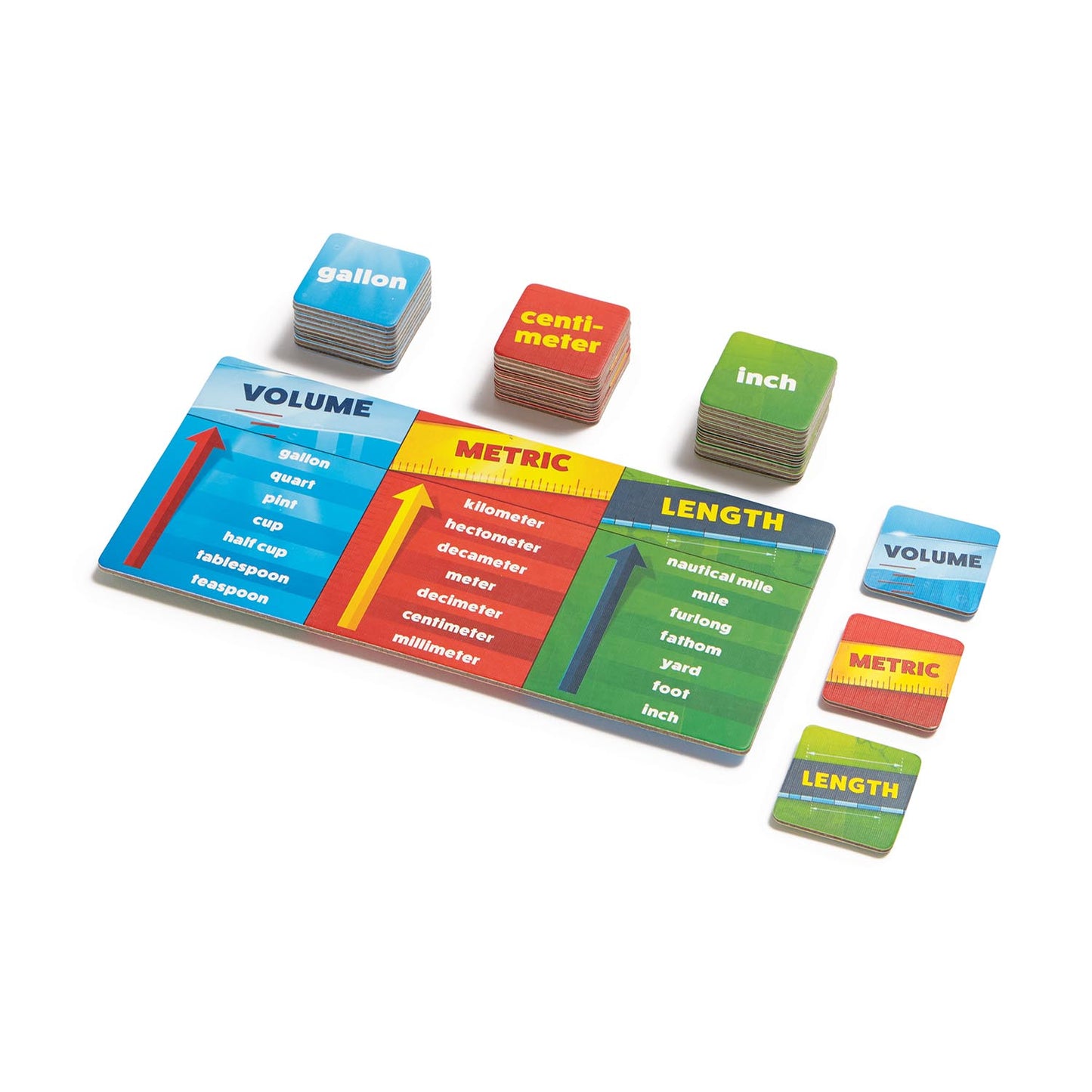
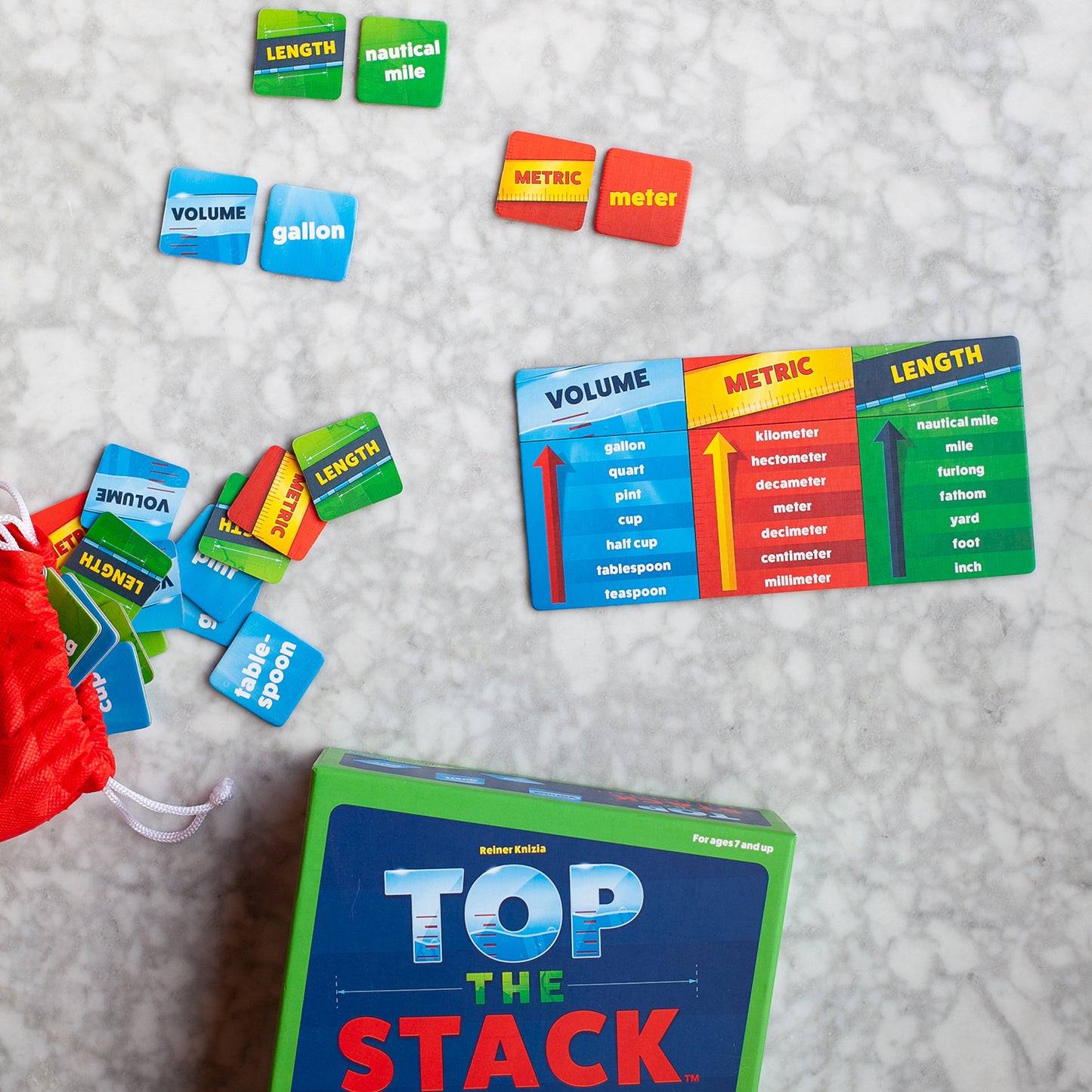
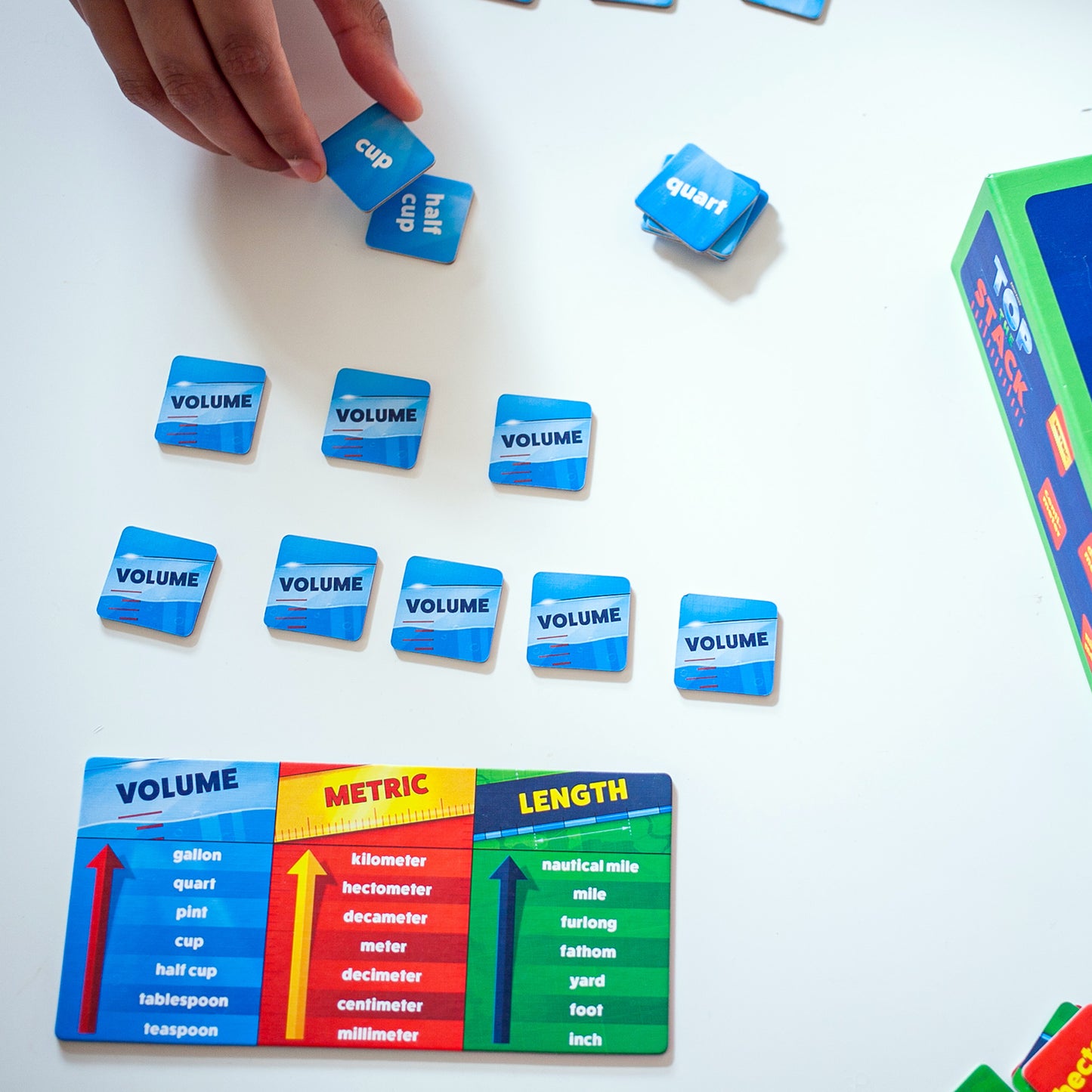
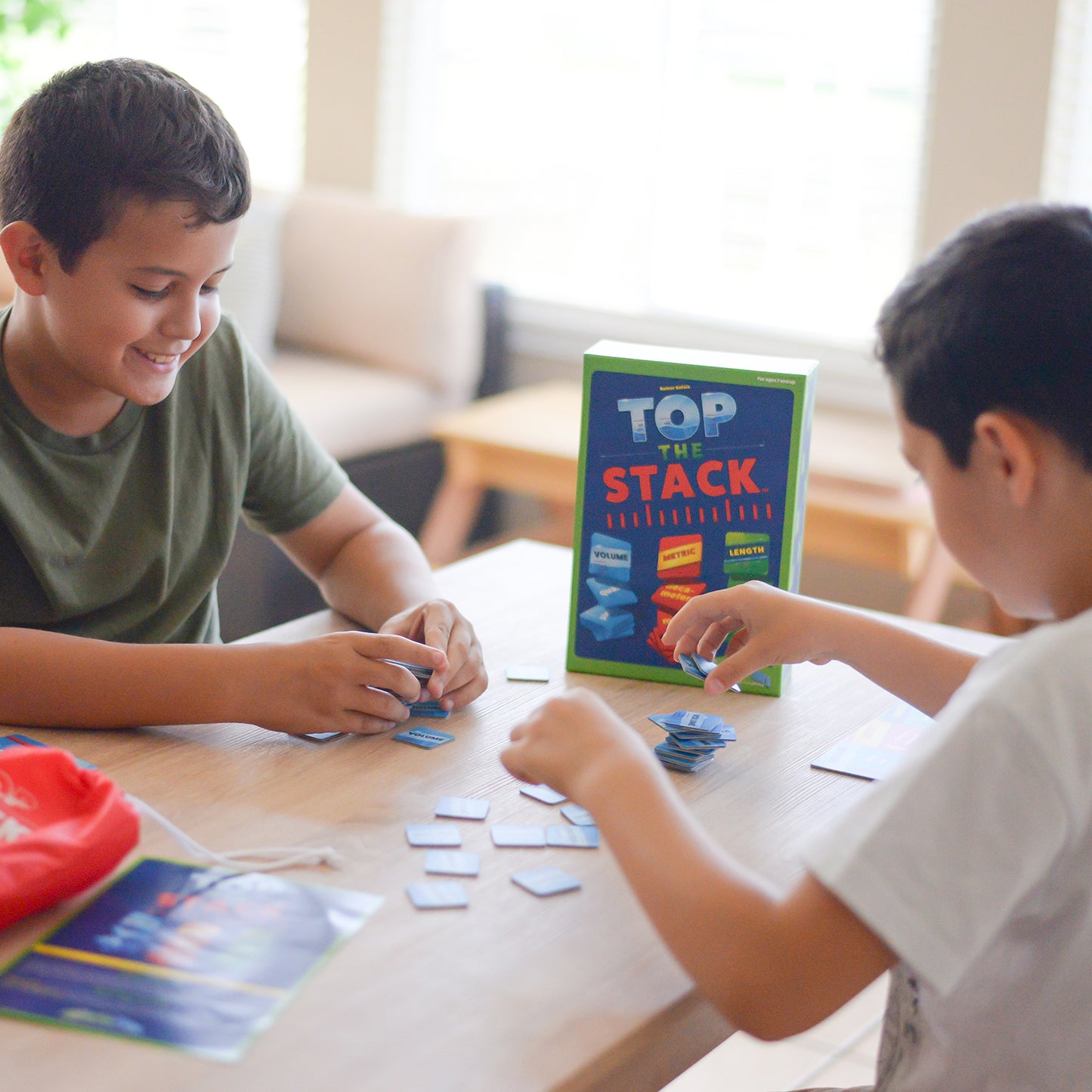
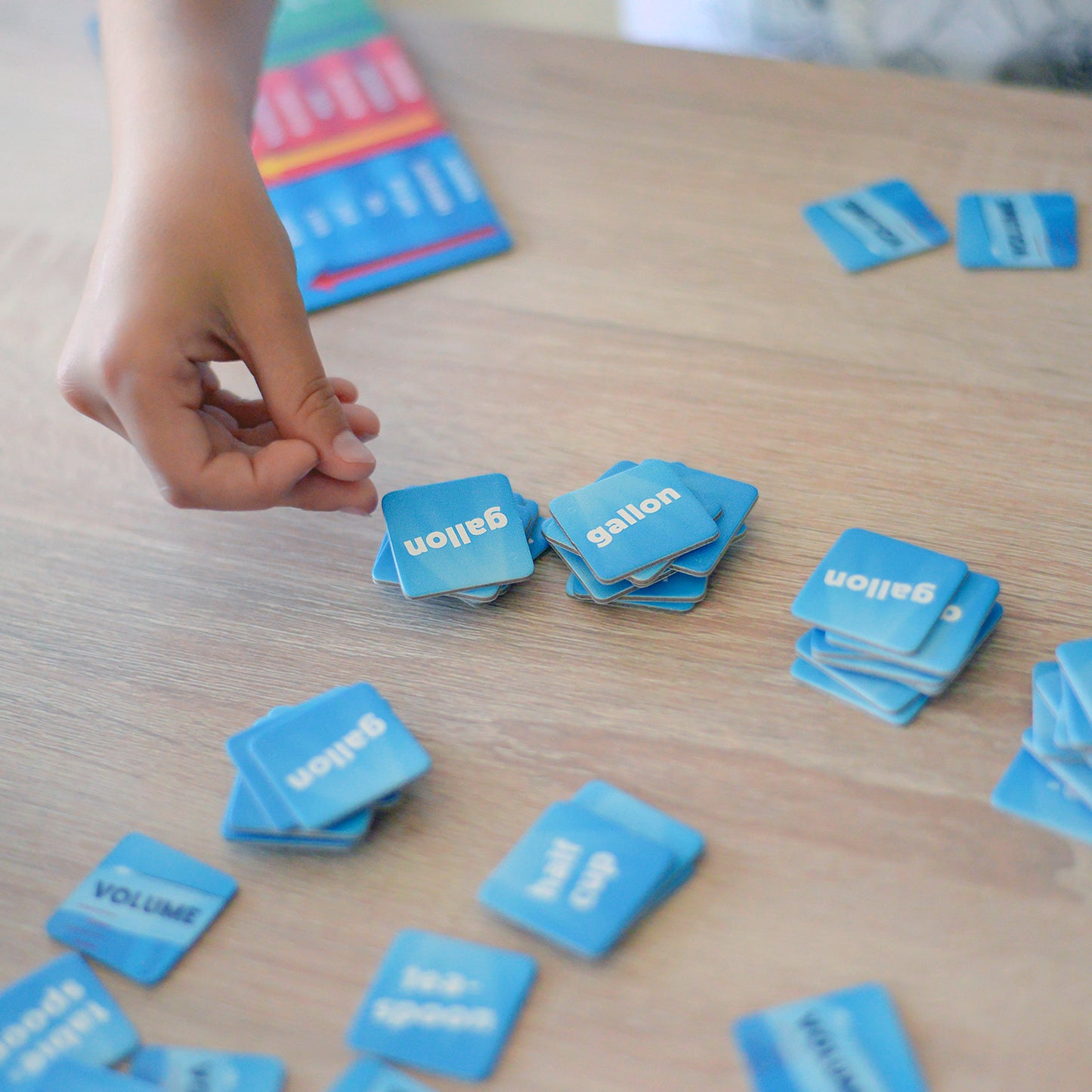
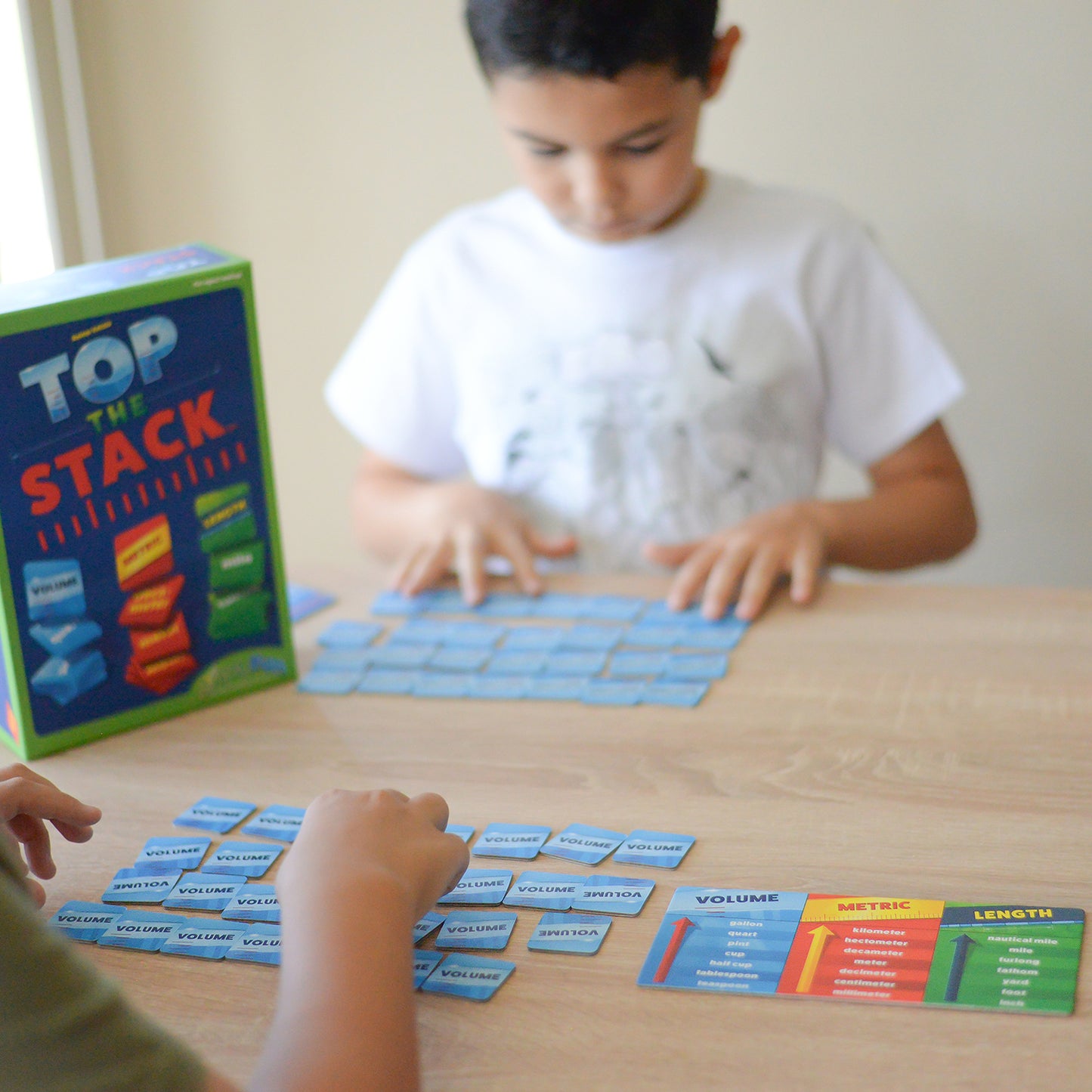
Collapsible content
Today we’re going to see how we measure up with our memory skills as we learn to play Simply Fun’s Top the Stack.
Top the Stack is a terrific math and measurement game for 2 to 4 players and is designed for people ages 7 and up.
In every Top the Stack game box you’ll find:
Three sets of measurement tiles – 56 tiles for each measurement system. Tiles go from teaspoons to gallons, inches to miles, and millimeters to kilometers.
There are also 2 measurement guides that help players remember the stack order and basic comparisons of the different measurements.
Finally, a handy storage bag keeps the tiles in order.
Top the Stack players will learn about measurement as they stack units of volume and length – even in the metric system – from smallest to largest.
They’ll also learn to practice focus and self-control by watching the values and being ready to place their tiles on the stacks at the right time.
To set up the game, select which measurement system to play – volume, length or metric – and place all the tiles of that measurement face-down in the middle of the play area. Put the remaining tiles in the bag and return them to the box.
Place the measurement guides in between players so they can be referenced during play.
Now, mix up all the tiles, still face down and divide the tiles between all the players equally. For three player games the youngest player will receive one less tile.
Players should arrange their tiles in rows, face down, in front of them.
In Top the Stack, all players play at the same time. To begin everyone shouts, “Top the Stack!” together.
Quickly, all players look at the values on their own tiles, one at a time, without revealing them to the other players. Once they’ve seen the value on a tile, they memorize it and then return it to its face down position.
Note that players may not rearrange their tiles and can only lift one tile at a time.
When a player sees the smallest value measurement in the system, they immediately place it face-up it in the center of the of play area. This begins the first stack.
All players continue looking through their tiles, one by one, to find either: 1) the smallest value to start a new stack, or 2) the next value to place on top an existing stack.
As players find the smallest value tiles and place them in the middle, there will be multiple stacks in play. Players need to be quick and focused to place the next tile on the stack before anyone else does!
Players may look at the reference guides if they are unsure of the next value. And players work to make sure that tiles are stacked in the correct order.
If a player makes a mistake, they must take back the incorrect tile and place it face down in front of them to use later.
When a player has only three tiles left, they shout, “Top the Stack!” and win the round.
The remaning players count the tiles still in front of them and receive one penalty point for each tile not played.
Play continues with two more rounds – of the same or different measurements – the player with the fewest penalty points after three rounds is the winner.
For an easier version of the game, players may choose to play all three games in a row with the same measurement system.
For more advanced play, each of the three games should be played with a different system, volume, length and metric, to declare a winner.
If you think fast and stack faster, you’ll measure up with Simply Fun’s Top the Stack!


Core Standard*: None


Explore
What Does Child Do To Use Skill In The Game?
Players explore in two ways playing Top The Stack. They need to continuously examine the stacks and turn over their own tiles to find the right one to play.
How Parents Can Assist Learning
This game requires children to explore throughout the game. Encourage children to take their time to look carefully as they turn over tiles.
Learning Implications and Educator Support
Top the Stack is a good game for developing focus and self-control as children need to attend to all the stacks being created in the play area while turning over their own tiles to find the right one to play. Encourage children to take their time to look carefully as they turn over tiles.
Determine
What Does Child Do To Use Skill In The Game?
Players need to decide which tile to play in sequence or if they can start a sequence with the lowest value tile.
How Parents Can Assist Learning
Since this is a speed game, remind players that they need to place a correct tile quickly.
Learning Implications and Educator Support
This is a good game for developing the ability to balance quick action (placing a tile) with accuracy (looking closely at your tiles to pick the correct one).
Compare
What Does Child Do To Use Skill In The Game?
Players may compare the word on a tile (ex: Fathom) to the Measurement Guide to make sure they know where the tile fits in the sequence.
How Parents Can Assist Learning
If you notice children putting a tile in the incorrect spot, review the Measurement Guide with them. Practice putting the tiles in the correct sequence before playing the game again to make sure the children know the proper order such as a foot follows an inch.
Learning Implications and Educator Support
Top the Stack is great for teaching sequencing with specific focus on volume, imperial length and metric length. If you notice children putting a tile in the incorrect spot, review the Measurement Guide with them. Practice putting the tiles in the correct sequence before playing the game again to make sure the children know the proper order such as a foot follows an inch.
Remember
What Does Child Do To Use Skill In The Game?
Players need to remember the measurement sequences so they know which tile comes next. Players will also be faster if they remember where a desired tile is located in their field of overturned tiles.
How Parents Can Assist Learning
This game requires children to explore throughout the game. Encourage children to take their time to look carefully as they turn over tiles. To boost memory, children can say the name of their tiles as they turn them over. Combining visual and verbal elements together has been show to significantly increase short term memory versus just using visual or verbal individually.
Learning Implications and Educator Support
Top the Stack is a good game for developing focus and self-control as children need to attend to the stacks being created in the play area while turning over their own tiles to find the right one to play. This means children are exploring throughout the game while under time pressure to add to a stack before another player. Encourage children to take their time to look carefully as they turn over tiles which will allow them to remember where desired tiles are located while also avoiding misplaying a tile in the incorrect sequence.
Practice
What Does Child Do To Use Skill In The Game?
Players are practicing sequencing throughout Top the Stack game play.
How Parents Can Assist Learning
When children are first learning the game, practice putting the tiles in the correct sequence before playing to make sure they know the proper order, such as a foot follows an inch.
Learning Implications and Educator Support
Top the Stack is great for teaching sequencing with specific focus on volume, length and metric length. When children are first learning the game, practice putting the tiles in the correct sequence before playing to make sure they know the proper order, such as a foot follows an inch. Teachers can also incorporate the tiles into other classroom activities to help children learn general sequencing skills as well as volume and length vocabulary and sequences.
Solve
What Does Child Do To Use Skill In The Game?
Because other players are racing to place their tiles to start and build stacks, the top tiles on each stack are rapidly changing. To win the game, players need to adapt to the changing stacks while using speed and memory to place all their tiles correctly before the other players.
How Parents Can Assist Learning
No special adult support is required. However, if you notice children putting a tile in the incorrect spot, review the Measurement Guide with them. Practice putting the tiles in the correct sequence before playing the game again to make sure the children know the proper order such as a foot follows an inch.
Learning Implications and Educator Support
No special adult support is required. However, if you notice children putting a tile in the incorrect spot, review the Measurement Guide with them. Practice putting the tiles in the correct sequence before playing the game again to make sure the children know the proper order such as a foot follows an inch.
*Data compiled from CCSSI ELA Standards, WA Science Standards, and Washington Social Studies Standards


Communication
Suggestions for How to Modify Play Experience
The vocabulary related to measurement may be new to the child. Introduce the words and their meaning before playing the game. Words such as "fathom" and "furlong" may be unfamiliar to many players. Once everyone knows the meaning of each term, play can begin.
Top The Stack does not require communication. Also, because everyone will be concentrating on their own quick moves, most communication will probably take place between games. Encourage discussion of play and how players approached the game for group learning and bonding.
Sensorimotor
Suggestions for How to Modify Play Experience
A stack of tiles does not need to be neatly aligned. However, if children have fine motor problems and cannot pick up and place tiles quickly, they will be at a disadvantage in Top the Stack.
Social Emotional/Behavioral
Suggestions for How to Modify Play Experience
Children with impulsive behaviors may make quick, incorrect decisions while playing. Make sure children know that incorrect tiles will need to be taken back. Remind them to look over all tiles and refer to the Measurement Guide before choosing a tile to play.
Children who become easily frustrated and act out may find the game too challenging. Play first without the timed factor. Take turns finding a tile and placing it. Once children have successfully worked through the measurement sequence, they may be more confident to play.
Vision
Suggestions for How to Modify Play Experience
The Measurement Tiles and Measurement Guide may be difficult for low vision players to read, thus, the game is not a good choice for them.
Hearing
Suggestions for How to Modify Play Experience
Children with hearing impairments should not have a problem with Top The Stack as no communication is required in the game.
*Data compiled from CCSSI ELA Standards, WA Science Standards, and Washington Social Studies Standards


Autism Strengths & Interests
Short Summary of Strengths & Interests
- Understands length and volume measurement terms.
- Can make size comparisons in sequence.
- Can quickly shift focus from one place to another to make comparisons.
Is good at matching visual items
Is This Game Appropriate? Yes
Description
Players use matching to see if the value of one of their tiles has already been placed on top of a stack. If so, the player needs to find the next value up in the sequence to play on that stack or turn their attention to other stacks.
Has a good memory for sensory details, including visual, touch, taste and smell
Is This Game Appropriate? Yes
Description
Top The Stack requires children to have a good memory for the relationship of different measurements, such as an inch is shorter than a foot or a pint is less than a quart. Fortunately, the game includes a Measurement Guide allowing players to learn the meaning and relationship of each measurement, and to be a support during game play to help children determine the next measurement in a sequence.
Has a good memory for words, phrases and dialouge
Is This Game Appropriate? Yes
Description
Children who have good verbal memory will hone that skill playing Top The Stack. Whether they already know the meaning of the different measurements or learn them as a result of the game, the stronger their memory for the words and sequence becomes...the greater speed they will have playing the game.
Has a good memory for pictures, numbers and patterns
Is This Game Appropriate? Yes
Description
The memory for the measurement sequence is aided by ability to remember numbers and relationships among them. Children who can visual relationships, remember numbers and see the pattern in the relationships will excel with Top the Stack.
Likes to put things in order or a sequence
Is This Game Appropriate? Yes
Description
The whole intent of Top the Stack is to sequence items in a size sequence for measurement options. Children who can sequence abstract concepts (ex: numbers, the alphabet) without concrete manipulative (ex: blocks) will do well with this game.
Learns through visualizing or "replaying" actions in their mind
This game is not appropriate
Likes activities with rules, such as math and phonics
Is This Game Appropriate? Yes
Description
Understanding the relationships among components within a measurement category requires understanding rules. For example, the metric system relies on the base of 10 for calculating length. Thus, Top The Stack will likely be engaging for children who enjoy activities that follow straightforward rules and relationships.
Is very concrete and literal
This game is not appropriate
Learns in small "chunks" (for example, phone numbers are 3 chunks of number xxx-xxx-xxxx that are combined together)
Is This Game Appropriate? Yes
Description
Measurements start with a specific size unit. Chunks of those units then comprise the next named measurement element, and so on. The chunking patterns help the child remember the sequence, especially for the metric system.
Is good at nonverbal reasoning and logic
Is This Game Appropriate? Yes
Description
Although the child might understand all of the concepts in the game, Top The Stack requires reading words to play the game.
Likes spatial problem solving
This game is not appropriate
Can read well with good vocabulary, though may not fully comprehend content
Likes to use and has good fine motor skill
Is This Game Appropriate? Yes
Description
The game requires being able to rapidly stack small tiles, which could be a great showcase for children who enjoy using their fine motor skills.
Likes established routines or set ways of doing things
Is This Game Appropriate? Yes
Description
The game is played the same way every time. Even though the measurement category may change, the play sequence and sequencing remains the same. Thus, Top The Stack should be not be frustrating for children who prefer predictable ways to play. If the child does not like to switch categories, play the game with just one category for each play session.
Likes manipulating, constructing or building things
This game is not appropriate
Likes to use and has good musical abilities
This game is not appropriate
Likes to use and has good drawing skills
This game is not appropriate
Autism Special Considerations
Appears to ignore other's communication and/or has difficulty giving eye contact to a communication partner
Is This Game Appropriate for Child with Characteristic? Yes
Can Child with Characteristic Play Game w/o Modification? Yes
Strategies for Developing Compensatory Skills:
In Top the Stack players have to concentrate on the tiles being stacked rather than other players.
Has difficulty understanding complex verbal directions
Is This Game Appropriate for Child with Characteristic? Yes
Can Child with Characteristic Play Game w/o Modification? No
Strategies for Developing Compensatory Skills:
The directions for Top The Stack are somewhat complex, as players need to understand when to stack on their own or others' tile stack and when to start a new stack. This may be confusing to some children. For those children, practice the game by just building one stack. Then, play by building only 2 stacks, and so on until the child is comfortable with the complete game.
Uses vocabulary inaccurately or demonstrates echolalia (repeating another's speech)
Is This Game Appropriate for Child with Characteristic? Yes
Can Child with Characteristic Play Game w/o Modification? Yes
Strategies for Developing Compensatory Skills:
The game requires concentration, which may reduce echolalia, as others will not be talking during play.
Gets stuck repeating a verbal topic or physical actions and/or has difficulty attending to others' actions or topic.
Is This Game Appropriate for Child with Characteristic? Yes
Can Child with Characteristic Play Game w/o Modification? Yes
Strategies for Developing Compensatory Skills:
Children need to be able to shift their attention from their own stacks to others' in order to see the best moves. This will not prohibit play, but may reduce the chance of winning.
Has difficulty producing speech/communication
Is This Game Appropriate for Child with Characteristic? Yes
Can Child with Characteristic Play Game w/o Modification? Yes
Strategies for Developing Compensatory Skills:
Communication is not needed to play, but discussion of strategy is encouraged.
Has difficulty sequencing multi-step actions and/or doing complex abstract tasks
Is This Game Appropriate for Child with Characteristic? No
Can Child with Characteristic Play Game w/o Modification? No
Strategies for Developing Compensatory Skills:
Measurement of volume and length in both imperial and metric approaches requires abstract thinking skills. This may be too difficult for many children with autism.
Demonstrates difficulty initiating and maintaining social interactions
Is This Game Appropriate for Child with Characteristic? Yes
Can Child with Characteristic Play Game w/o Modification? Yes
Strategies for Developing Compensatory Skills:
Social interaction is not needed to play, but may develop as players vie for the same stacks for their tiles.
Acts out or demonstrates avoidance behaviors when frustrated, overwhelmed, or needs more sensory input.
Is This Game Appropriate for Child with Characteristic? No
Can Child with Characteristic Play Game w/o Modification? No
Strategies for Developing Compensatory Skills:
Top The Stack is fast-paced and requires concentration and may not be a good match for children who are easily frustrated, distracted, or overwhelmed.
Has short attention span for non-preferred activities
Is This Game Appropriate for Child with Characteristic? No
Can Child with Characteristic Play Game w/o Modification? No
Strategies for Developing Compensatory Skills:
Top of the Stack is not recommended unless the child likes fast-paced, abstract math games. On the other hand, children who have a preference for math and understand measurement concepts may like this game.
Needs sameness or consistent routines and/or has difficulty with transitions from one activity to another
Is This Game Appropriate for Child with Characteristic? Yes
Can Child with Characteristic Play Game w/o Modification? No
Strategies for Developing Compensatory Skills:
The game can shift from metric to imperial length or volume in different games. This shift may be difficult for some children. Because the games are played the same way, the adults can model how the next game is played the same way.
Provide the measurement guide to let children study the sequence.
To practice, play with children by stacking the tiles in order for each topic (metric, imperial, volume) to give them the physical feel of the process.
Has difficulty understanding others' feelings, intentions, and the reasons for others' actions.
Is This Game Appropriate for Child with Characteristic? Yes
Can Child with Characteristic Play Game w/o Modification? No
Strategies for Developing Compensatory Skills:
Players do not have to understand other players' thinking or feeling.
*Data compiled from CCSSI ELA Standards, WA Science Standards, and Washington Social Studies Standards


Extra Ways to Play the Game
Divide up one set of tiles with equal number and terms for each player. Players then build their own stacks following the remainder of the game rules. Whoever gets finished first wins. Make sure to check the sequence for correctness.
Materials Needed
No additional materials needed.
Developmental Benefits
The advantage of this alternative is that each pile can be checked for accuracy. With the traditional rules, when piles are finished, if a mistake was made it may not possible to know who made the error. This is a good way to start with children who are just learning the measurement sequence. They can check themselves for accuracy.
Extra Ways to Play the Game
Play Top the Stack as a memory game. Turn all tiles face down, and take turns turning up two tiles looking for matches.
Materials Needed
No additional materials needed.
Developmental Benefits
Playing Top the Stack as a memory game may be a good way to introduce the terms in the game before playing the game as the rules are written. This allows players to become familiar with the terms and discuss their meaning before the actual speed game is played.
Extra Ways to Play the Game
Rather than using one category (ex: volume), use four tiles of each type of tile (ex: pint) in two categories (ex: volume and metric length). Build stacks for each, following the rules of the game. Then play with all three categories, with four of each tile from each set.
Materials Needed
No additional materials needed.
Developmental Benefits
This expansion adds an element of mental challenge and complexity, as players are required to remember two or three categories and their sequences. This is a double or triple sequencing challenge. Players must recall which measurement category is represented by a tile that is turned over as well as the place that tile fills in the sequence.
*Data compiled from CCSSI ELA Standards, WA Science Standards, and Washington Social Studies Standards
- Choosing a selection results in a full page refresh.
- Opens in a new window.








